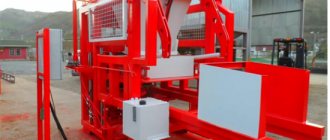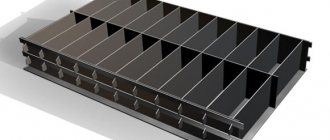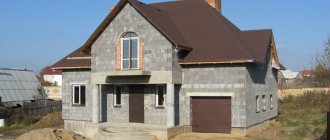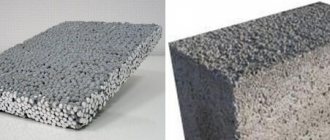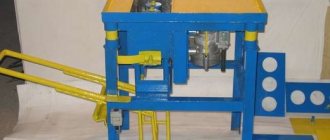The construction of country houses is very popular. People are increasingly using stone products as building materials. They create an alternative to expensive and less durable wood. Today, when building a private house, you can use not only brick, but also various blocks that are cheaper.
During construction, you can significantly save money on purchasing ready-made blocks if you start producing them yourself. In addition, after building the house, all the equipment necessary for production will remain, which can be used for a small private business.
A machine for making cinder blocks with your own hands, which device to choose
A vibrating machine is a device for compacting concrete mixture under pressure using vibration. Properties of a product made in this way:
- dense structure;
- strength;
- wear resistance;
- frost resistance;
- low thermal conductivity;
- light weight with large dimensions;
- low cost.
There is no single standard for a finished design. Machines are divided according to the following characteristics:
- control method (manual or automated);
- productivity (number of blocks produced per 1 cycle);
- type of products (monolithic or hollow);
- convenience.
The vibrating machine must be selected depending on the upcoming volume of construction. When work requires a small amount of building materials or they are needed situationally, then a machine of a simple design with a productivity of 1 block per 1 cycle of work is suitable.
For large-scale construction, as well as for the production of blocks for sale, it is advisable to acquire a unit with which you can make several products in one production cycle. It can be equipped with a device to facilitate the removal of blocks, a lift, etc. This minimizes manual labor while maintaining high productivity.
It is not difficult to make a cinder block machine with your own hands; the materials for this are available and do not require large financial investments.
Forming methods
Do-it-yourself bathhouse made of expanded clay concrete blocks: step-by-step instructions and the best projects with 52 photos and 2 videos
Factory molds for preparing cinder blocks are made of reinforced concrete or steel. Such parts can easily withstand the weight of a large volume of solution. As for do-it-yourself molds, they are most often made of wood or steel sheets. Such elements largely play the role of special formwork.
To save on raw materials and free time, molds are mainly assembled without a bottom. You can put a simple film under them. Thanks to this method, the entire process of block formation can be significantly simplified. It must be remembered that the forms themselves must be made of perfectly smooth wood parts. The working surface will be a concrete base, a table with a flat and smooth tabletop, or a sheet of iron, which also does not have any defects.
Let's take a closer look at how to make a mold for slag blocks:
- you need to choose sanded boards 14 cm long (the width should be a multiple of this parameter);
- then, using a hacksaw, you need to separate the segments, which will then play the role of transverse partitions;
- then you will need to connect the segments with longitudinal elements to form a rectangular frame;
- Next, you need to cut a sheet of steel or any other material with a smooth surface into separate plates measuring 14x30 cm;
- in the inner part of the resulting structure, cuts are made that will act as grooves, the width of which is equal to the dimensions of the dividing strips;
- then the sections responsible for the separation are fixed in cuts, creating a mold for the production of 3 or more slag blocks.
In order for the resulting container for hardening the solution to serve as long as possible, at the final stage it is recommended to coat both metal and wood structures with oil-based paint. This form is suitable for preparing cinder blocks, the dimensions of which are 14x14x30 cm.
Advantages of making a machine yourself
Advantages of a homemade device:
- A do-it-yourself cinder block making machine costs less than a purchased one.
- Cheaper delivery. If during construction you need to replenish the supply of blocks, you can make the missing building materials directly on the construction site. This is especially convenient if construction is taking place outside the city. You don't have to go to the store to load and unload materials.
- There is no need to buy cinder blocks with a reserve. You can make them with precision down to one piece.
- When producing slag concrete products yourself, it is easy to control the components included in the solution. This is insurance against low-quality building materials. You can be sure that the cinder concrete solution does not contain toxic or other harmful components.
- After completion of construction work, the vibrating machine can be sold.
Vibropress in the production of cinder blocks
The brick press is a powerful tabletop, which is equipped with special springs
The brick press is a powerful tabletop, which is equipped with special springs. On an industrial scale, such equipment is always at hand, but at home it is not. In order to make a vibrating machine for the production of cinder blocks you will need:
- high-speed electric motor with two shafts, with a power of at least 0.5 kW;
- grinder and electric welding;
- iron sheet (thickness 3 mm);
- fittings (diameter 12 mm).
The vibration process will take no more than 15 seconds, then the vibration form is removed in a vertical position and within a day the finished blocks can be laid.
In essence, a brick press for cinder blocks is a regular tabletop equipped with springs. The vibration process occurs due to a shift of the center of gravity to the eccentric (see example of a brick making press in the photo)
Homemade machine with a vibrating device: what is required for this
Tools and materials you will need:
- electric welding machine;
- angle grinder for metal work;
- vice;
- locksmith tools;
- electric motor (500-750 W);
- metal sheet and strip (3 mm);
- pipes (75-85 mm);
- bolts, nuts;
- sheet rubber.
Sequencing:
- The size of the form is determined. You can use standard sizes (400x200x200 mm). If blocks of a different size are needed, they are measured and the shape is designed based on the obtained values.
- A drawing is being prepared.
- Using a grinder, the walls of the mold are cut out of metal. The number of side walls is determined by the number of compartments. You can make 1,2 or more identical compartments. The output will be the same number of cinder blocks. The simplest machine contains 1 compartment.
- The side edging is assembled by welding. First you need to grab the metal and make sure that it is connected correctly. After this, weld it completely.
- Metal tubes are cut to the height of the mold. You need to make longitudinal cuts on the sides and form cone-shaped cylinders.
- The cones are welded to the bottom of the matrix. A transverse jumper is made between them, and plugs are placed on top.
- The bottom is welded to the side edging.
- The matrix tray is lined with rubber to protect the bottom edge from damage.
- For stability, you can weld strips from profile pipes with a small cross-section.
- Handles are attached to the side for moving and lifting.
- The thread is installed and the electric motor is attached to it.
- The top cover is screwed in, in which holes are made for the cones. The cover must correspond to the internal dimensions of the matrix.
- An anti-corrosion coating is applied.
- A test run of the installation is performed. It will show you what adjustments need to be made.
Additional Information! A homemade vibrating machine for expanded clay blocks works on the same principle.
Features of the material
Cinder block is a building material that has proven itself to be one of the most durable and unpretentious. It has considerable dimensions, especially if you place an ordinary brick next to it. You can make slag blocks not only in a factory setting. Some craftsmen undertake this work at home. If you strictly adhere to the technology, you get high-quality and strong blocks from which you can build a house or any outbuilding.
If a decision has been made to independently produce such products, then a number of its features should be taken into account.
- Cinder block is a fireproof material. It does not ignite itself, and does not intensify an existing flame.
- Really good quality blocks make long-lasting and sustainable homes/outbuildings. Such buildings will not be harmed by harsh climatic conditions, hurricanes, or constant gusty winds.
- Repairing cinder block buildings does not require extra effort and free time - all work can be completed in a short time.
- Cinder blocks are also distinguished by their large sizes, thanks to which buildings made from them can be erected very quickly, which pleases many builders.
- This material is durable. Buildings built from it can stand for more than 100 years without losing their previous characteristics.
- Another feature of cinder block is its soundproofing component. Thus, in dwellings made from this material there are no annoying street noises.
- The production of cinder blocks is carried out using various raw materials, so it is possible to select the optimal products for any conditions.
- What distinguishes cinder block is that it is not subject to attacks by various kinds of parasites or rodents. In addition, it does not rot, so it does not have to be coated with antiseptic solutions and other similar compounds designed to protect the base.
- Despite their decent dimensions, such blocks are light in weight. This feature is noted by many masters. Due to their lightness, these materials can be easily moved from one place to another without calling a crane. However, it must be taken into account that some types of such products are still quite heavy.
- Cinder block is not afraid of low temperatures.
- These blocks are distinguished by their high heat capacity, thanks to which they make cozy and warm homes.
- Temperature fluctuations do not harm the cinder block.
Cinder block buildings are usually decorated with decorative materials to give a more aesthetic appearance.
However, it is very important to remember that the cinder block cannot be covered with ordinary plaster (any “wet” work with this material should not be carried out). You can also use a special decorative block, which is often used instead of expensive cladding. When working with cinder block, it is important to take into account one important feature - this material is characterized by high water absorption, so it must be protected from contact with moisture and dampness
Otherwise, the blocks may collapse over time. Unfortunately, the geometry of the slag blocks leaves much to be desired. That is why, when laying floors from such material, you will have to constantly adjust individual elements - trim them and saw them. Cinder blocks have a relatively low cost.
Drying
Drying is another important step in the production of slag blocks. The production process itself usually takes about 2-4 days. Sufficient strength characteristics that allow you to proceed to the use of blocks are usually achieved after 28 days. This is exactly the amount of time needed to obtain high-quality building material suitable for carrying out certain works. Cinder blocks can also dry naturally. Typically, this process takes place using a simple method of producing materials (in conventional forms).
To dry cinder blocks, special chambers are often used to prevent cracking during the hardening process. To prevent the blocks from becoming cracked, they must be moistened from time to time. This process is especially relevant if the production process is carried out in hot weather.
Financial plan
A small wood concrete production business requires a monthly capacity of at least 500 m3. Primary investments include the following items:
- station mixing components - 120 thousand rubles;
- several molds (minimum 30 pcs.) – 110 thousand rubles;
- kit for manual tamping – 15 thousand rubles;
- drying chamber – 350 thousand rubles;
- metal pallets – 30 thousand rubles;
- chipper – 150 thousand rubles;
- cement and wood chips dispenser – 50 thousand rubles;
- other expenses – 75 thousand rubles.
Total: 900 thousand rubles.
It is recommended to include in the list of monthly expenses:
- rental of premises of at least 250 m2 – 80 thousand rubles;
- purchase of raw materials – 800 thousand rubles;
- payment for utilities (water, electricity, heating) – 40 thousand rubles;
- salary – 90 thousand rubles;
- marketing campaign – 110 thousand rubles;
- other expenses – 50 thousand rubles.
Total: 1260 thousand rubles. every month.
Now about income: monthly sales of 500 m3 of wood concrete blocks (70% at wholesale prices, 30% at retail prices) allows you to count on receiving an income of 1,475 thousand rubles. As a result, the monthly profit will be 315 thousand rubles. That is, the business profitability value is 27%.
How to build a business in the production of cinder blocks - see this article.
How to draw up a business plan for the production of paving slabs - read here.
Basic requirements for cinder block production
Standard product dimensions are 180*90*390 mm, each block usually has 3 holes
The standard dimensions of the product are 180*90*390 mm, each block usually has 3 holes. The production technology involves the use of M400 type cement mortar, as well as the addition of the required proportion of blast furnace slag and sand. Cinder block production involves hand-making and the use of a cinder block machine. It is worth noting that one bag of cement mixture allows you to make about 36 blocks. The product must be in perfect shape, otherwise small irregularities or deviations can lead to poor wall laying. To obtain the correct geometry, the cinder block mold is filled to the end with a small slide; during vibration, the solution will shrink and lie flat. The solution is prepared in the following proportion:
- 7 parts slag;
- 2 parts sand;
- 1, cement parts;
- no more than 3 parts water.
Additional components you can add are ash, broken brick, sawdust or gypsum. But to increase the moisture resistance and strength of the product, you can add a plasticizer (see example in the photo), only 5 grams is enough.
If you are planning to make building material yourself, it is important to know that it is better to carry out the production process in a room where the resulting material can be properly dried. It is advisable to choose a location for the production of cinder blocks close to sand quarries or cement plants.
It is advisable to choose a location for the production of cinder blocks close to sand quarries or cement plants.
Mixture composition
The production of slag blocks at home obliges the craftsman to adhere to a specific composition, as well as certain proportions of all components. Thus, the binding ingredient in this material is usually cement of a grade not lower than M400. As for the filling component, it can consist entirely of slag or be mixed. The last option is obtained by adding a small amount of crushed stone, sand (simple or expanded clay), crushed brick and fine expanded clay.
When making cinder blocks, the following proportions must be observed:
- 8-9 parts of the filling component;
- 1.5-2 parts of astringent ingredient.
For example, out of 9 parts, at least 6 are accounted for by this component, and the rest is made up of crushed stone and sand. In theory, when making it yourself, it is permissible to use concrete or brick scraps, screenings.
The standard proportions of cinder block are:
- 2 parts sand;
- 2 parts crushed stone;
- 7 parts slag;
- 2 parts of Portland cement marked M400.
As for water, it is customary to add it in an approximate ratio of 0.5 parts. The result is a semi-dry solution. To ensure its high quality, you need to take a small handful and throw it on a hard surface. If the thrown lump crumbled, but under compression conditions regained its previous shape, then the composition can be considered suitable for further use.
If you plan to obtain colored cinder blocks, then the recipe is supplemented with colored chalk or brick chips. To increase the strength characteristics of this material, special plasticizers are used. In some cases, they resort to adding gypsum, ash or sawdust.
Do I need permission to open?
To legalize the production of wood concrete blocks, it is necessary to obtain permission from Rospotrebnadzor. To do this, they will need to provide a certain list of documents.
The production of wood concrete blocks includes: 1. Wood chips are loaded into the mixing station and aluminum sulfate is added. Calcium chloride can be used as a replacement. 2. Adding, after splitting cement and water and mixing until smooth. 3. Delivery of the finished mixture to the compaction site, where it is loaded into pre-prepared forms. For compaction, the vibration method with a weight or using hand tampers can be used. 4. Removing the finished product from the mold. However, at least 2-4 days must be allowed before they can be stacked on top of each other, moved and transported.


